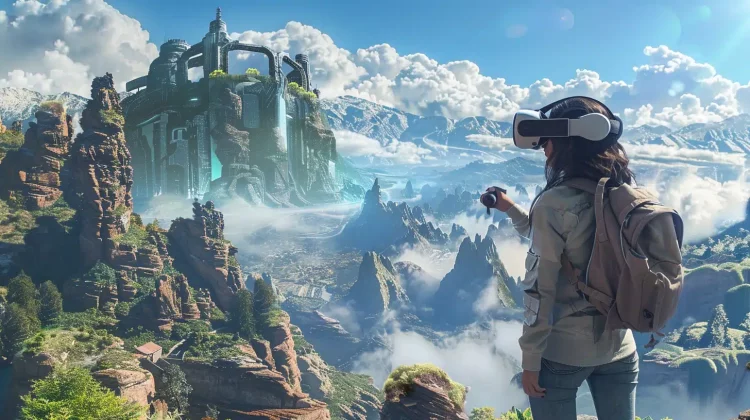Introduction: The Impact of VR on the Travel Industry
The travel industry has long been a catalyst for human connection, cultural exchange, and exploration. However, as technology has evolved, so too has the way we experience the world around us. In recent years, Virtual Reality (VR) has emerged as a transformative tool that is changing the way people approach travel. By offering immersive, interactive experiences, VR is revolutionizing the travel industry, from how people explore destinations to how they plan their trips and even how they interact with hotels and other travel services.
At its core, Virtual Reality enables users to experience and interact with digital environments as though they were physically present. The sense of immersion, driven by advanced graphics, spatial sound, and often even haptic feedback, provides a powerful tool for the tourism sector. Instead of imagining a trip or relying on static images, travelers can step into fully realized virtual spaces that replicate the destinations, cultures, and experiences they dream of.
This article explores the various ways in which Virtual Reality is transforming travel, from virtual tourism to hotel accommodations, and looks at the role it plays in cultural preservation. Furthermore, it examines the potential future developments of VR in the travel industry and its broader implications for tourism in the digital age.
Virtual Tourism: Exploring Destinations from the Comfort of Home
Virtual tourism is perhaps the most immediate and obvious application of VR technology in the travel industry. Traditionally, when people wanted to explore new destinations, they would rely on travel guides, brochures, and online reviews to form an impression of a place. However, these resources often provide only a limited view of what a destination has to offer. VR allows potential travelers to virtually step into a city, explore its streets, visit its landmarks, and even interact with virtual representations of local people.
For example, VR companies such as “YouVisit” offer users the ability to explore various global destinations, from the streets of Paris to the beaches of the Maldives. By putting on a VR headset, users can walk around famous landmarks, check out local culture, and even get a feel for the atmosphere of a place without ever leaving home. These experiences are far more immersive than watching a video or browsing through photographs, providing travelers with a sense of what it’s like to be physically present.
Virtual tourism is especially beneficial for individuals who may not have the means, time, or health to travel. Senior citizens, people with disabilities, or individuals in remote areas now have the opportunity to explore parts of the world they might never have had access to otherwise. For some, virtual tourism may be a stand-in for the real thing, while for others, it acts as a preview to spark curiosity and excitement about potential future trips.
Moreover, virtual tourism also serves the purpose of inspiring travelers. When people experience a place through VR, they may be more likely to book a real trip there. VR, therefore, acts as a form of marketing tool for tourism boards, allowing them to showcase destinations in a way that is far more engaging than traditional advertising.
VR Travel Previews: How VR is Helping Tourists Plan Trips
Planning a trip can be an exciting but overwhelming process. With so many destinations, accommodations, and activities to choose from, how can travelers decide where to go and what to do? VR is increasingly being used as a tool to help tourists plan their vacations, providing them with an opportunity to experience destinations and accommodations before booking.
One of the most innovative applications of VR in trip planning is the virtual tour. Travel agencies and tour operators have begun offering VR-based previews of popular tourist destinations and resorts, allowing potential travelers to virtually “visit” these locations and see if they match their expectations. For instance, Marriott Hotels launched its “VRoom Service,” a VR travel preview service that allows guests to use VR headsets in hotel rooms to take virtual tours of different destinations around the world. By using immersive VR, travelers can virtually explore the best sights, sounds, and experiences of a location without having to leave their hotel room.
For travel agencies, this use of VR provides a competitive edge, allowing them to offer highly interactive and personalized trip-planning experiences. Tourists can preview accommodations, view scenic attractions, and even “try out” activities like hiking, skiing, or snorkeling. The ability to see destinations in such an immersive manner helps potential travelers make informed decisions, minimizing the uncertainty and stress that often comes with booking trips.
VR technology has also made it possible for tourists to check out multiple hotels or resorts without physically traveling to each one. In the past, booking a hotel would often involve a lot of research, from reading online reviews to browsing through photos and videos. With VR, potential guests can take a 360-degree tour of a hotel’s rooms, pools, dining areas, and other amenities to get a true sense of what it would be like to stay there.

Immersive Experiences in Hotels: How VR is Changing Accommodations
The way we experience accommodations has also been revolutionized by Virtual Reality. As technology advances, hotels are increasingly adopting VR to enhance their guests’ experiences, providing them with a deeper level of immersion and entertainment. Hotels can now offer VR-powered amenities, such as virtual concierge services, VR-based entertainment options, and even virtual room previews for prospective guests.
A prime example is the use of VR in hotel rooms themselves. Major hotel chains like Hilton and Marriott are offering VR headsets as part of their in-room entertainment options. Instead of traditional television or streaming services, guests can use the headset to explore virtual worlds, watch immersive films, or even take virtual tours of nearby attractions. This not only enhances the guest experience but also serves as a marketing tool, drawing attention to the hotel’s commitment to modern, tech-driven hospitality.
Hotels can also use VR to provide guided tours of their facilities, allowing guests to explore the property and get a feel for the amenities before arrival. Some luxury hotels have integrated VR systems that allow guests to book spa treatments, choose their meals, or explore nearby attractions without leaving the hotel.
For business travelers, VR can be used to attend virtual meetings or events. This opens up a whole new world of possibilities for international conferences or events, as attendees can participate remotely using immersive VR platforms without needing to be physically present. As remote work and virtual collaboration become more prevalent, the integration of VR into hotel spaces will continue to play a crucial role in modern accommodations.
Cultural Experiences: Virtual Reality’s Role in Preserving Heritage
Beyond entertainment and travel planning, Virtual Reality also plays a vital role in preserving cultural heritage. VR technology is being used to recreate and preserve historical sites, monuments, and cultural landmarks that are in danger of being lost due to natural disasters, climate change, or human interference.
For example, UNESCO and other cultural institutions have partnered with VR companies to digitally preserve significant cultural heritage sites such as the ancient ruins of Pompeii, the pyramids of Egypt, or the historic city of Palmyra in Syria. Through VR, people can explore these important landmarks in their original form, even if they can no longer visit the sites in person due to political unrest, natural damage, or other challenges.
Furthermore, VR is being used to preserve traditional cultural practices that may be in danger of fading away. Through immersive experiences, VR allows people to learn about and engage with cultural traditions, dance, rituals, and art forms that might not be accessible otherwise. For example, VR projects have enabled people to experience traditional Aboriginal ceremonies in Australia, Japanese tea ceremonies, or indigenous American storytelling in ways that preserve cultural knowledge and allow it to be shared across generations.
By preserving cultural heritage through VR, we are ensuring that future generations can experience and learn from these valuable aspects of human history, even if they cannot physically visit the sites or interact with the communities that hold these traditions.
The Future of VR Travel: What’s Next in Immersive Tourism
As VR technology continues to advance, its potential to transform the travel industry only grows. The future of immersive tourism looks particularly exciting, with a host of new possibilities on the horizon.
One of the most promising developments is the integration of VR with other cutting-edge technologies, such as Augmented Reality (AR), Artificial Intelligence (AI), and 5G connectivity. This will allow for even more interactive and personalized travel experiences. Imagine walking through a city with a VR headset and receiving real-time information about landmarks and historical facts as you explore. With AI-driven guides, VR can even customize the experience based on your preferences, recommending places, activities, and experiences that align with your interests.
Another exciting prospect is the development of VR-based virtual vacations. With the rapid evolution of immersive tech, it’s becoming increasingly possible for travelers to experience full-fledged vacations entirely through virtual means. In the future, tourists could “travel” to distant parts of the world without leaving their homes, experiencing everything from sightseeing and cultural festivals to dining and adventure sports through virtual reality.
Moreover, as the metaverse continues to develop, VR could become a key element of digital tourism. Virtual worlds and environments will likely become major destinations themselves, with people spending more time in digital spaces and interacting with others in these virtual realms. These digital destinations could even become more popular than physical travel, particularly for those seeking to avoid the environmental costs and logistical challenges of real-world travel.
Conclusion: The Role of Virtual Reality in the Future of Travel
Virtual Reality has already begun to reshape the way people think about travel. From virtual tourism that enables people to explore the world from their homes, to the use of immersive VR for trip planning, cultural preservation, and hotel experiences, the potential applications of VR in the travel industry are vast and still evolving.
As technology continues to improve, VR will likely play an even larger role in shaping the future of travel, offering new ways for people to experience destinations, plan trips, and even engage in cultural exchange. The future of VR travel is bright, and it promises to bring more immersive, inclusive, and sustainable travel experiences to people across the globe.
















































Discussion about this post